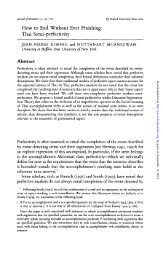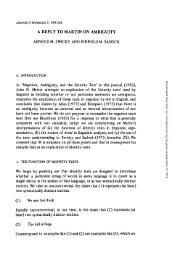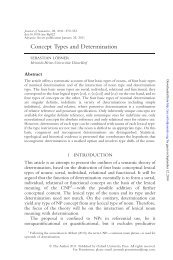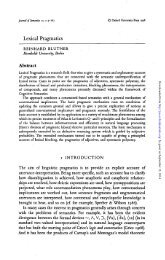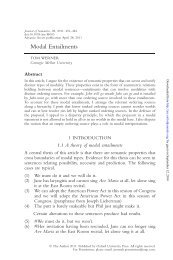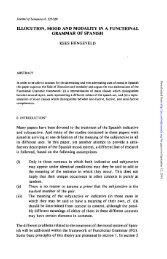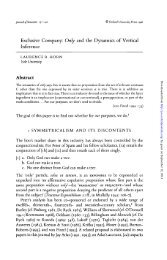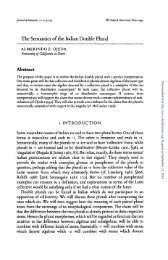Aspectual Coercion and Logical Polysemy - Journal of Semantics
Aspectual Coercion and Logical Polysemy - Journal of Semantics
Aspectual Coercion and Logical Polysemy - Journal of Semantics
You also want an ePaper? Increase the reach of your titles
YUMPU automatically turns print PDFs into web optimized ePapers that Google loves.
140 <strong>Aspectual</strong> <strong>Coercion</strong> <strong>and</strong> <strong>Logical</strong> <strong>Polysemy</strong><br />
predicates. We also demonstrate why commencer <strong>and</strong> finir (finish) allow coercion<br />
while cesser (cease) <strong>and</strong> arreter (stop) do not.<br />
4 THE RELEVANCE OF EVENT STRUCTURE<br />
In order to underst<strong>and</strong> better the behavior <strong>of</strong> aspectual coercion, we review our<br />
assumptions regarding the structure <strong>of</strong> events as encoded by lexical items. We<br />
begin with the uncontroversial assumption that events can be subclassified into<br />
at least three sorts: processes, states, <strong>and</strong> transitions. Furthermore, we assume,<br />
following Pustejovsky (1991b), a subeventual structure to these event sorts as<br />
well. This has the advantage <strong>of</strong> allowing principles <strong>of</strong> predicate-argument<br />
binding to refer to subevents in the semantic representation, a move which has<br />
significant theoretical consequences (cf. Moens & Steedman 1988; Grimshaw<br />
1990; Pustejovsky 1991b; <strong>and</strong> Moens 1987). Evidence from unaccusativity,<br />
aspectual predicates, <strong>and</strong> the varied nature <strong>of</strong> causative constructions show,<br />
however, that even this notion <strong>of</strong> event structure does not fully explain the<br />
underlying behavior <strong>of</strong> semantic projection to argument positions in the<br />
syntax. We will adopt an event structure analysis employing the notion <strong>of</strong><br />
headedness in order to account for the richer range <strong>of</strong> syntactic behavior.<br />
In Pustejovsky & Busa (1994), the event constructions first introduced in<br />
Kamp (1980) <strong>and</strong> van Benthem (1983) are extended to a model called an<br />
'extended event structure' in order to represent the relation between an event<br />
<strong>and</strong> its proper subevents. An extended event structure is a tuple,



